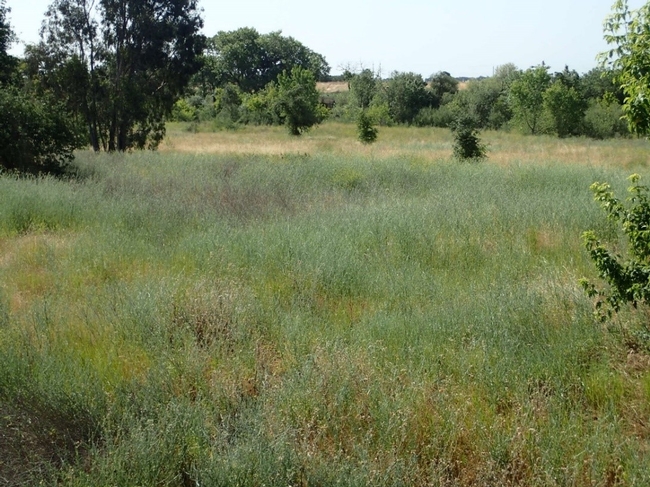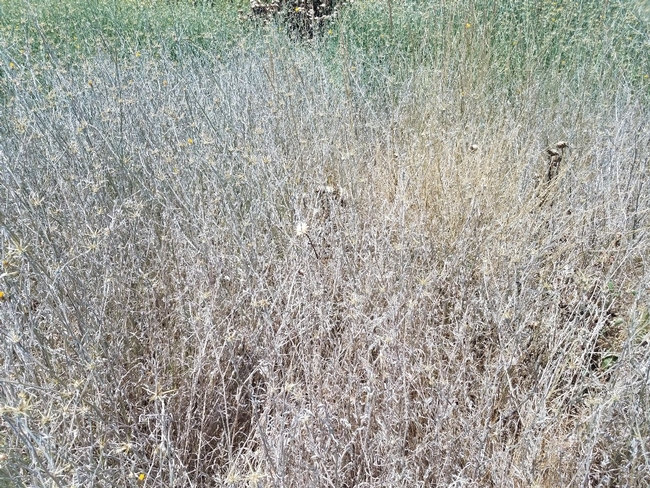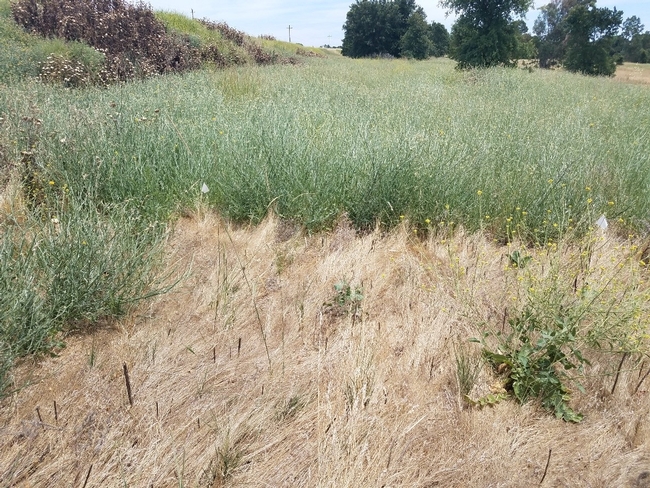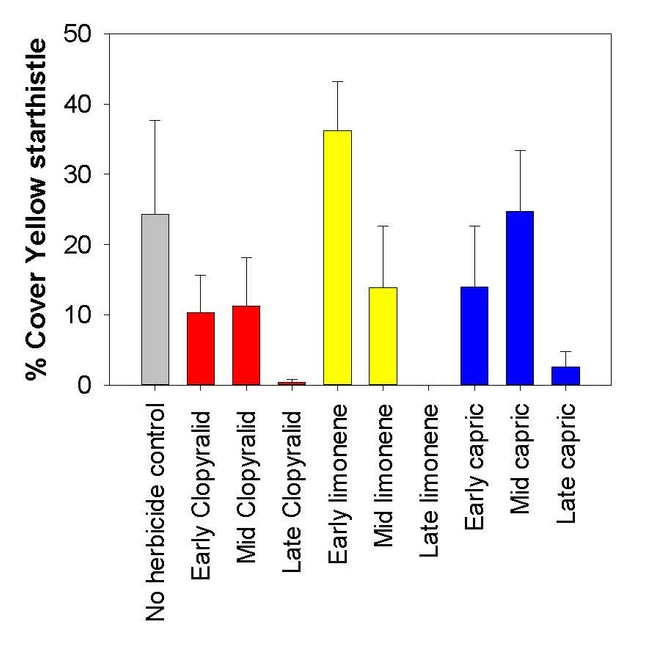Valerie Eviner is a Professor of Ecosystem Management and Restoration in the Department of Plant Sciences at UC Davis.
Yellow starthistle is a noxious weed common in many areas of California's grasslands, and is often a priority for control, due to its effects on decreased livestock carrying capacity, decreased plant diversity, and interference with recreational uses (reviewed in DiTomaso et al. 2006). A number of conventional herbicides are highly effective in controlling yellow starthistle (DiTomaso et al. 2006, USFS 2014), but in many settings, there is increased pressure to decrease use of conventional herbicides and find alternative control methods.
Organic herbicides have received increased attention, including in the UC Weed Science Blog (https://ucanr.edu/blogs/blogcore/postdetail.cfm?postnum=5623, https://ucanr.edu/blogs/UCDWeedScience/index.cfm?tagname=organic%20herbicide), but often require repeated applications when trying to control plants during the growing season (Reiter and Windbiel-Rojas 2020).

When considering the use of organic herbicides, it is important to not just substitute them into management protocols for conventional herbicides, but to consider their mode of action, and how that may shape promising approaches for their use. For example, D-Limonene (Avenger) and Capric and Caprylic acids (Suppress) contact-kill tissues, but are not systemic. This may make their effectiveness weaker when controlling weeds during the growing season, but could be promising in killing flowers and preventing seeding, as has been found with a number of conventional herbicides on yellow starthistle (DiTomaso et al. 2006), and in the use of both conventional herbicides and the organic herbicide Suppress in decreasing flowering of Wooly Distaff Thistle (DiTomaso et al. 2017).
To assess whether these organic herbicides could provide effective control of yellow starthistle, we collaborated with Putah Creek Riparian Reserve to compare the effects of the timing and type of herbicide on yellow starthistle. Plots were mowed in December 2018 to assure good contact of the organic herbicides with growing plants. In 3 m x 3 m plots (7 replicates per treatment), we applied one of four herbicide treatments (no herbicide (control), the conventional herbicide Transline (clopyralid), the organic herbicide Avenger (D-Limonene), and the organic herbicide Suppress (caprylic and capric acids). These were applied in the spring of 2019 at 3 timings: early spring, mid-spring, and then at the initiation of yellow starthistle flowering in the late spring (see table below for details on applications).
In the year of treatment, only the early and mid-spring applications of Transline decreased yellow starthistle, essentially eliminating it (see Photo 2), and there were no effects of the organic herbicides on the cover of yellow starthistle.
However, all three herbicides applied at flowering resulted in damage to yellow starthistle (see Photo 3.)

In the following growing season, vegetation cover assessed in the late spring of 2020 showed that the most effective control of yellow starthistle was achieved from the late-season (at flowering) spray in the previous year—with equally effective control of the organic herbicides and Transline (Figure 1).
Of course, more time is needed to assess the long-term effects of late-season applications of organic herbicides, but based on two years of results, organic herbicides applied during the growing season have little effect on yellow starthistle, but applications at flowering are promising. Late-season applications are also beneficial because most desirable plants have already senesced at this time, providing the opportunity for yellow starthistle control with minimal unintended effects on other vegetation.
References:
DiTomaso, JM, GB Kyser, and MJ Pitcairn. 2006. Yellow starthistle management guide. Cal-IPC Publication 2006-03.
DiTomaso, JM, GB Kyser, DJ Lewis and JA Roncoroni. 2017. Conventional and organic options for the control of Wooly Distaff Thistle (Carthamus lanatus). Invasive Plant Science and Management 10: 72-79.
USFS. 2014. Field guide for managing yellow starthistle in the Southwest. USDA TP-R3-16-07.
Reiter, M and K Windbiel-Rojas. 2020. Organic herbicides and glyphosate for weed control: results of coordinated experiments in urban landscapes. CAPCA Advisor Magazine. February 2020. Pp 24-30.


